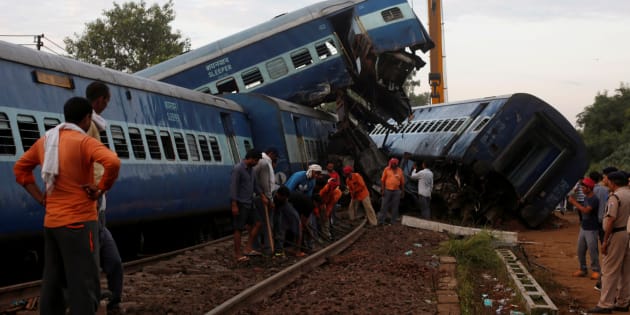Derailments drove the toll up.
21/08/2017
Rukmini SEditor, Data & Innovation

ADNAN ABIDI / REUTERS
The last year was the deadliest year for the railways in the the 17 years for which data is available, official data shows. Derailments in particular drove the numbers up to its deadliest level in 17 years.
In response to a question asked in the Rajya Sabha two weeks ago, Minister of State for Railways, Rajen Gohain, said that 238 persons had lost their lives in "consequential train accidents" during the year 2016-17. Of these, 193 deaths were from derailments alone, the highest ever number of deaths from derailments in the 17 years for which data is available. The most significant of the derailments in 2016 was that of the Indore-Patna Express in November 2016, in which at least 150 people died near Kanpur. In most other years, the biggest contributor to rail deaths is unmanned level crossings.
The 2016-17 toll is higher than the death toll of 235 persons in 2010-11, the previous worst year for the Railways since 2000, according to data compiled by HuffPost Indiafrom the Ministry of Railways' annual statistical publications. (Two accidents made that year particularly deadly; the Gyaneshwari Express collision with a goods train after track sabotage by suspected Maoists derailed it and killed 141 people, and a collision between two trains at Sainthia station in West Bengal which killed at least 63 people.)
While Prime Minister Narendra Modi claimed in a UP election rally that the 2016 Kanpur derailment was the result of a "conspiracy from across the border", an allegation that was subsequently supported by rail minister Suresh Prabhu, no evidence of this has yet been found. Three men arrested and charged with planting explosives on a track in Bihar, which were subsequently defused, they were not charged with the Kanpur derailment.
With Saturday's derailment, the toll for 2017-18 is already at at least 34 persons, with at least 11 people having died at unmanned level crossings earlier in the year.
However, the number of accidents as well as the relative number of accidents for every million rail kilometres has been declining over time. Yet, as rail expert Rajendra B. Aklekar said, the railways is in urgent need of an infrastructure upgrade.
These numbers do not include deaths on railway tracks; over 25,000 people die after being hit by trains, usually while crossing railway tracks, every year, Gohain said in his reply to a separate question asked during the monsoon session of Parliament.



.jpg)
.jpg)



0 comments:
Post a Comment